German Shepherds are one of the world’s most popular and beloved dog breeds out there which is why you may ask yourself why would you ever want to mix it with anything.
Well, I’m sure I can bring up some points as to why an unusual pairing like the German Shepherd Coyote mix is a good alternative option.
The German Shepherd Coyote Mix is one of the more odd pairings, that much is certain as breeders don’t often deal with wild dog breeds, but some do.
The particular mix is what’s known as an interspecific hybrid rather than a straight up mixed breed and it uses the breed of Coyote called Canis Iatrans combined with the standard GSD.
The difference between a regular mixed breed and an interspecific hybrid is that the latter isn’t naturally occurring and it requires the interference of humans to happen in the first place.
Despite their many similarities, Coyote and German Shepherds belong to two different Canidae families which makes them mostly incompatible, but it ends up working nonetheless.
The simpler name for this type of hybrid is a Dogote or a Coydog, whichever one you prefer, though the latter is more of an umbrella term.
And, despite the potential dangers that owning a designer dog like this poses, some people still go for it.
To find out why this is the preferred choice of some folks, what benefits this mix brings over a standard GSD as well as find out answers to any other potential questions regarding the breed, do be sure to read on.
SEE ALSO: 23 German Shepherd Mixes That Will Melt Your Heart
What Is A German Shepherd Coyote Mix?
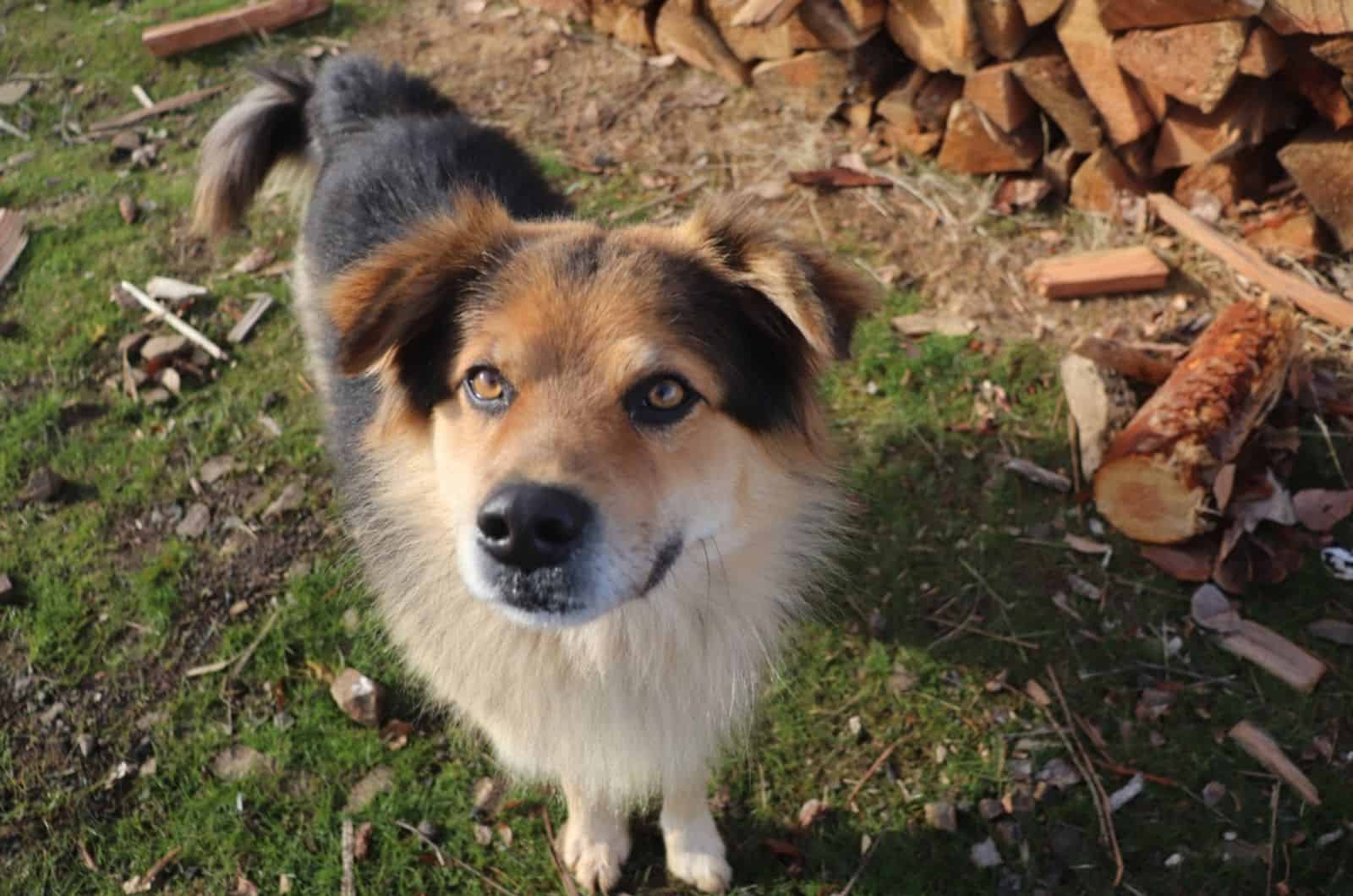
As mentioned earlier, it’s not a traditional hybrid dog, but rather an interspecific hybrid between two different canid families.
The result is the Coydog, but why would anyone want to cross a wild canid species with a domestic dog breed?
Well, there are several reasons, the first one being the fact that people have experimented with any sort of mix they could conceive of in the 90s, and they wanted to go as unique as possible.
This was about as unique as it got.
Another reason would be due to the Coyote’s extremely high energy level which, when paired with the discipline that a German Shepherd offers, created a very potent combination of guard dog and working dog.
This allowed him to undertake more strenuous effort.
That did come with the caveat or requiring more food on average though, but that much is to be expected.
And, finally, apart from the exotic nature of the Coydog, the coat color was another factor that was attractive to the people wanting one.
Even though most of the coat color options came from the German Shepherd, the Coyote’s brown color would serve as good camouflage and an extra level of defense for the mix against any would-be predators where the Coydog was used as a shepherd dog.
The Parent Breeds
Before we go into further detail regarding the Coydog, it’s important to discuss the two breeds that were the catalyst to creating it in the first place.
After all, making a Coydog takes so much effort on part of the breeder, particularly trying to align the mating cycles of the two breeds, so let’s find out what benefits this breed even has on top of the German Shepherd in the first place.
The German Shepherd
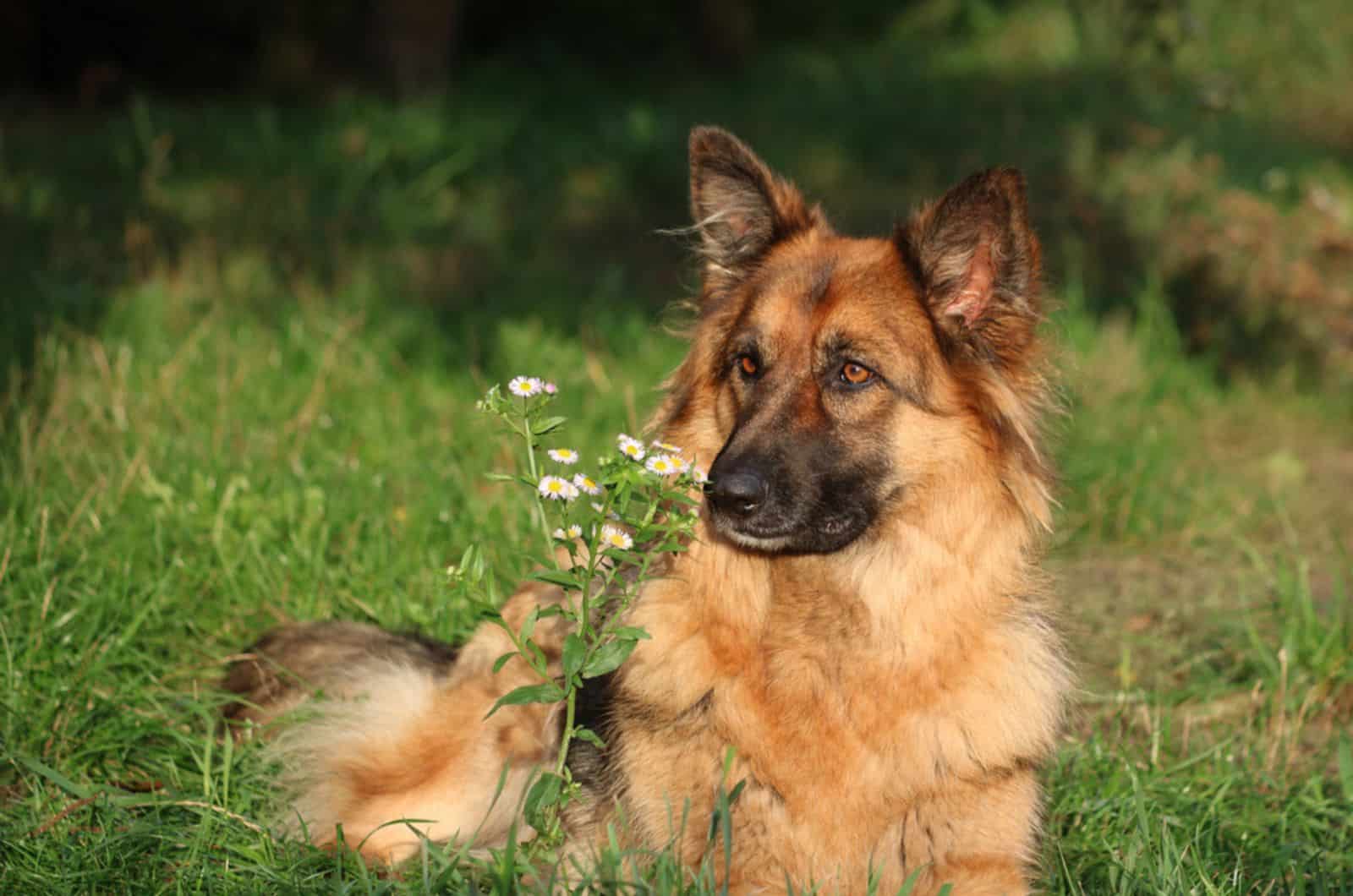
First up is the German Shepherd, the first breed that comes to mind when thinking of discipline and defense, the ideal watchdog.
Breed History
The German Shepherd, despite being one of the flagstone representatives of dog kind, is surprisingly not that old a breed, only coming in at the tail end of the 1800s.
Before the year 1891, there weren’t any particularly standardized dog breeds in Germany, at least as far as their shepherd dogs were concerned, instead there were plenty of breeds that performed similar duties, but had vast physical differences.
The so-called Phylax Society remedied that as it aimed to have the breeds conform to some sort of standard, or at least it tried to, but failed, though it was an inspiration for people to continue their work further down the line.
One man in particular, Max von Stephanitz, around the year 1899, saw the product of one of the first generations of German Shepherd, one raised through a lot of selective breeding and made to be the ideal working dog, at least in the eyes of Stephanitz.
He’d buy the dog and found the Society for German Shepherd Dogs of which his pooch, Horand von Grafrath, would be dubbed the first registered GSD of.
News spread fast and the society gained in popularity at a breakneck pace, gaining more and more members not just in Germany, but internationally, all of which wanted to be part of this legacy.
The first GSD fathered an astonishing number of children who would only continue on that route, primarily dealing with inbreeding in order to maintain the traits Stephanitz coveted so dearly.
The first modern GSD, one with the traits we know today, is believed to be Horand’s son, Beowulf.
Given the dog’s impeccable reputation, it was soon adopted to be more than just a working dog, but an army and guard dog as well, Nazi Germany in particular as it had the traits that their doctrine respected and they deemed it a good representative of it.
While a dark blemish on the breed’s otherwise stellar past, it’s one worth noting as the breed wasn’t at fault here.
They had other darker representations, namely being a favored breed of gangsters and other crooks of slightly higher caliber, but, in the later years, they also became a favorite for the police force, the well known K-9 units.
As for when they were introduced to our shores, that came around the year 1906, a little bit after they got popular in Germany and would get certified by the AKC (American Kennel Club) 2 years later, in the year 1908.
Appearance
Most people have seen or already know what a German Shepherd looks like, but it’s still worth pointing some characteristics out.
They’re considered to be an intermediary between medium and large dog breeds, coming in at around 25 inches for male representatives and around 23 inches for the female GSDs height wise.
As far as weight goes, that one has a more drastic difference, with the males being bulkier, sporting an impressive 75-80 pounds on average as adults while females are leaner, only carrying around 57-62 pounds on average.
Though, even with that, there’s still a lot of wiggle room as to what’s considered a healthy weight.
Their head forms a rather imposing figure with their longer muzzle which appears like it was chiseled from a rock with its square features, a darker nose, large, sharp teeth and a very powerful jaw.
Aside from that their forehead is somewhat domed, making them appear as if they’re glaring at their target or as if they’re focused.
Then you have their ears which stand upright, as if on alert, and are rather large in comparison to their head overall.
Its head movements often resemble that of their lupine ancestors with their long necks and positional adjustment depending on the type of movement that it’s performing.
Moving over to the body, the GSD is covered in a nice and dense double coat paired together with a thick undercoat, keeping him nice and warm during the cold winter months.
While medium fur length German Shepherds are the standard, you can also find long haired ones, albeit they’re a lot less common than the former.
Said fur comes most commonly in the familiar mix of tan and black, but there are various other options out there paired together with their various black body markings, but more on that a little later.
Finally, they have a relatively long and bushy tail that completes the beautiful ensemble of the ‘ideal working dog’, as Stephanitz would put it.
Temperament
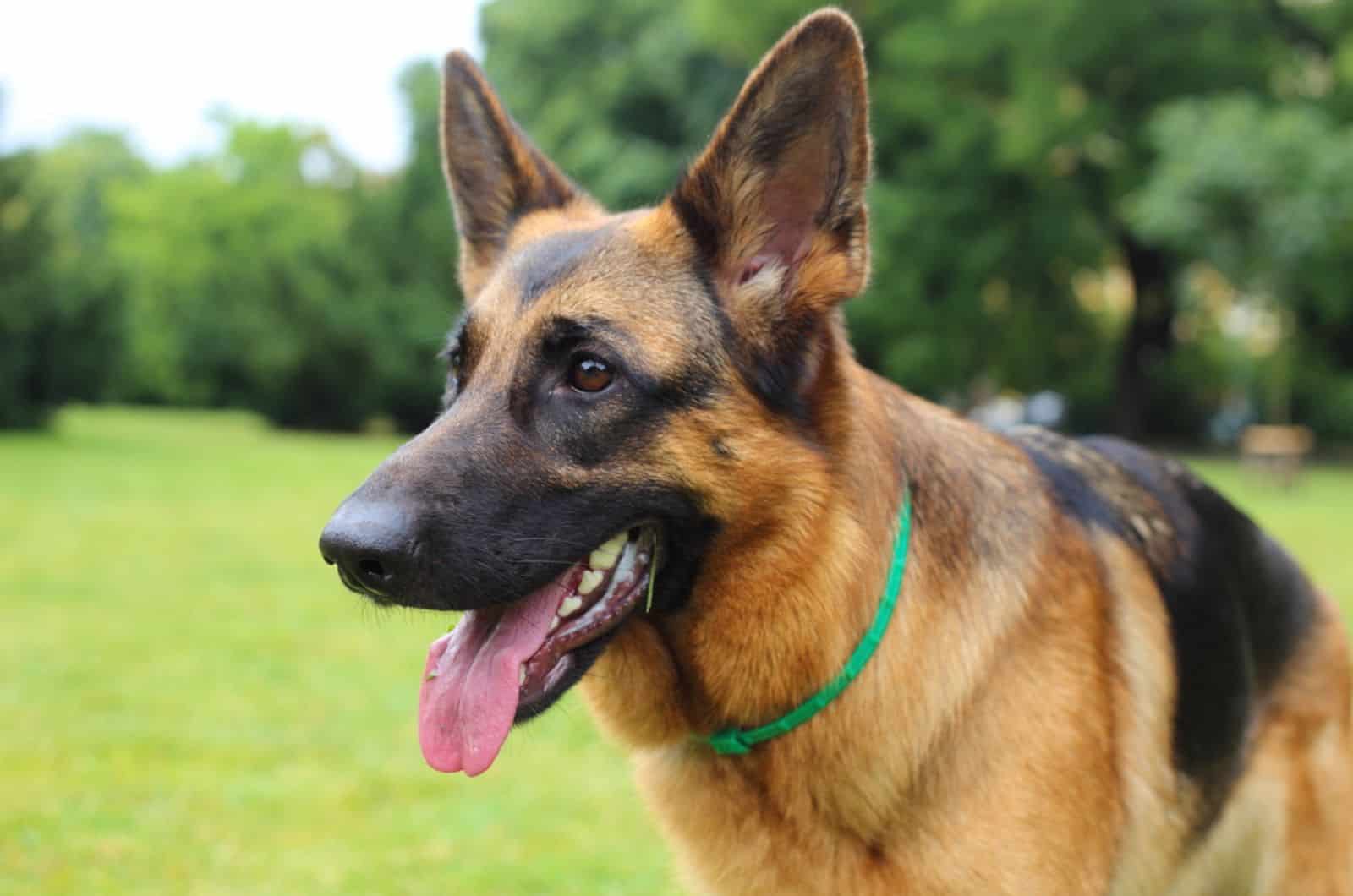
As mentioned before, a German Shepherd is the ideal type of dog in case you need one to guard property, watch out for intruders or be used as a general working dog due to their exceptional desire to do things and motivation to learn new things.
After all, their main intent was to be a herding dog, and they tend to not only be really active dogs, but also extremely intelligent ones.
They make for exceptional search dogs too once trained properly due to that same high level of curiosity toward discovery.
That said, they certainly do have temper problems and aren’t recommended for people who can’t reign that in.
They’re only really loyal to their family, but they tend to get a bit overprotective, wary of any strangers that may arrive at your doorstep.
On top of that, their high prey drive and ingrained shepherding nature will have them nipping away at your kids to try to get them to fall in line or similar which isn’t pleasant for them.
In terms of attacks on humans, they’re up there with Pit Bulls, albeit not nearly as common, but they are dangerous, mostly because people haven’t successfully trained them.
That’s why early socialization as part of their dog training is a must or else you’re going to end up with a problem on your hands.
Though, if you manage to complete their training properly they’ll be one of the most loyal and disciplined pets you could ever own.
Coat Colors
While the most common one that we end up seeing is black and tan, there are multiple other coat color options for the German Shepherd, albeit rare to see.
The standard colors are as follows:
- Black and Tan
- Black and Red
- Black and Silver
- Black and Cream
- Black
- Bi-color
- Sable
Of course, there are some non standard ones too, albeit not AKC certified, though with mixed breeds, it doesn’t really matter all that much.
Here are most of them:
- Gray
- Isabella
- Blue
- Blue and Tan
- Liver
- Liver and Tan
- White
Though, most, if not all of these colors can also come out lighter, seemingly washed out as well while still qualifying as a unique color.
Lifespan
The average lifespan of the German Shepherd is, by all counts, average when keeping large dog breeds into consideration, coming out at 9-13 years.
Despite seeming like too little, it’s the average for large breeds given how many health problems develop for them the older they get, particularly regarding the spine due to their center of gravity.
Through proper dieting and health check-ups, they can make that 13th year, but the average tends to be at around 10-11 years.
The Wild Coyote

Next up in this odd mix of things is the wild coyote, certainly the oddest possible pairing with another dog, but here we are.
Breed History
The “breed” is believed to have originated in North America, at least that’s what the oldest written record of them shows from the year 1750.
They’re described as smaller and more cowardly wolves than the ones encountered in Europe, skinnier too, but that they still retained the howling aspect.
The records further go on to the 1800s where they were spotted by several researchers, be they Lewis and Clark or various European traders that were passing by, some describing them as burrowing dogs, describing their packs as 10 to a dozen.
Coyotes are then further described as nestling near areas dense in wild game and hunt in packs as otherwise they’re too weak to stand up to a single prey animal on their own.
They go further down in their appearance as something more between a fox and a dog rather than a wolf, their size, ears and tail included, with the tail looking much scragglier than that of an actual fox.
The color would resemble a foxes too, albeit more of a paler reddish brown and green eyes.
Their first scientific description, that of Canis latrans, would come up at around the year 1819 by a man called Thomas Say who studied the ones on the Missouri River.
He further added the other possible coloration being gray with tinges of black on the back and made comparisons and distinctions that separated them from the regular prairie wolf.
Appearance
As you can see, there’s not much to say about the Coyote breed’s history given how they were never really domesticated, so most of it comes from scientific records and observations.
The same would be true for their appearance and temperament, but it’s worth noting for comparison with the Coyote Shepherd.
The size of the Coyote differs between genders with the males being the heavier of the two, going from 18 pounds all the way up to 44 while female representatives are a bit lighter, coming in anywhere from 15 to 40 pounds if they’re of healthy weight.
The range is massive, that much is true, but that’s due to their wild nature where their nourishment depends on the abundance of available food in the vicinity so it’s a different version of ‘healthy’ than it would be of domesticated dogs.
This is most evident when we look at Coyote packs from one US region and compare them to another.
Height isn’t something that’s recorded for them, but length is, with their lengths coming in at around 3 feet 3 inches to about 4 feet 5 inches.
Their visual appearance tends to differ as well, though the most common type of fur would be fulvous, carrying a sort of light gray or pale red coloration with some black and white speckling across the body.
The color mostly depends on the area that you’ll find them in, as they’ve evolved to better camouflage themselves in their surroundings.
The nose is often a black color, with some of it appearing bluish in nature.
The fur of the desert Coyote is short and quite scraggly due to lack of grooming and lack of owner, as expected of a wild canid species.
The fur of the mountain Coyote, on the other hand, is a bit denser to help protect from the cold with longer hairs.
As for their heads, they mostly resemble that of an in-between of a wolf and a fox, with a primarily lupine skull that sports longer ears than the average gray wolf and a larger top.
The muzzle and overall face area are thinner in comparison too.
Temperament

Needless to say, there aren’t exactly any training tips or proper temperament observations as there would be in a domestic purebred dog breed like a Border Collie, Labrador Retriever or a Husky.
They also don’t have any sense of trainability given that they’re a wild dog breed, but there are some things to point out.
Firstly, the Coyote tends to have a pack-oriented mentality, rarely ever found without one as hunting alone is almost impossible for them and will almost always lead to death by starvation.
In smaller groups, they tend to go for small animals and they rarely engage bigger game like goats or deer that can put up a fight, leaning more toward that fox-like attitude of preying on the weak when able.
This is why you’ll often see them attacking chicken coops of all things if no easier prey is available.
The usual mention of daily exercise needs need not apply as this isn’t a “dog” that you want to have in your home.
They’ll often display aggressive behavior toward other dogs and humans should they approach which isn’t exactly the best trait to have around.
Coat Colors
The Coyote has 3 different coat color options, none of them standard, that much is certain as it’s not an AKC certified breed, but the colors are as follows:
- Fulvous (a mix of pale red and light gray)
- Sable
- Gray and Black
Lifespan
The average lifespan of a Coyote is pretty long, reaching anywhere from 13 to 15 years, though that’s implying ideal conditions and captivity.
Coyotes in the wild rarely ever reach the age of 3 as they either die from starvation, or by being killed by another predator in a territorial dispute, the game they’re hunting or through road accidents.
The German Shepherd Coyote Mix
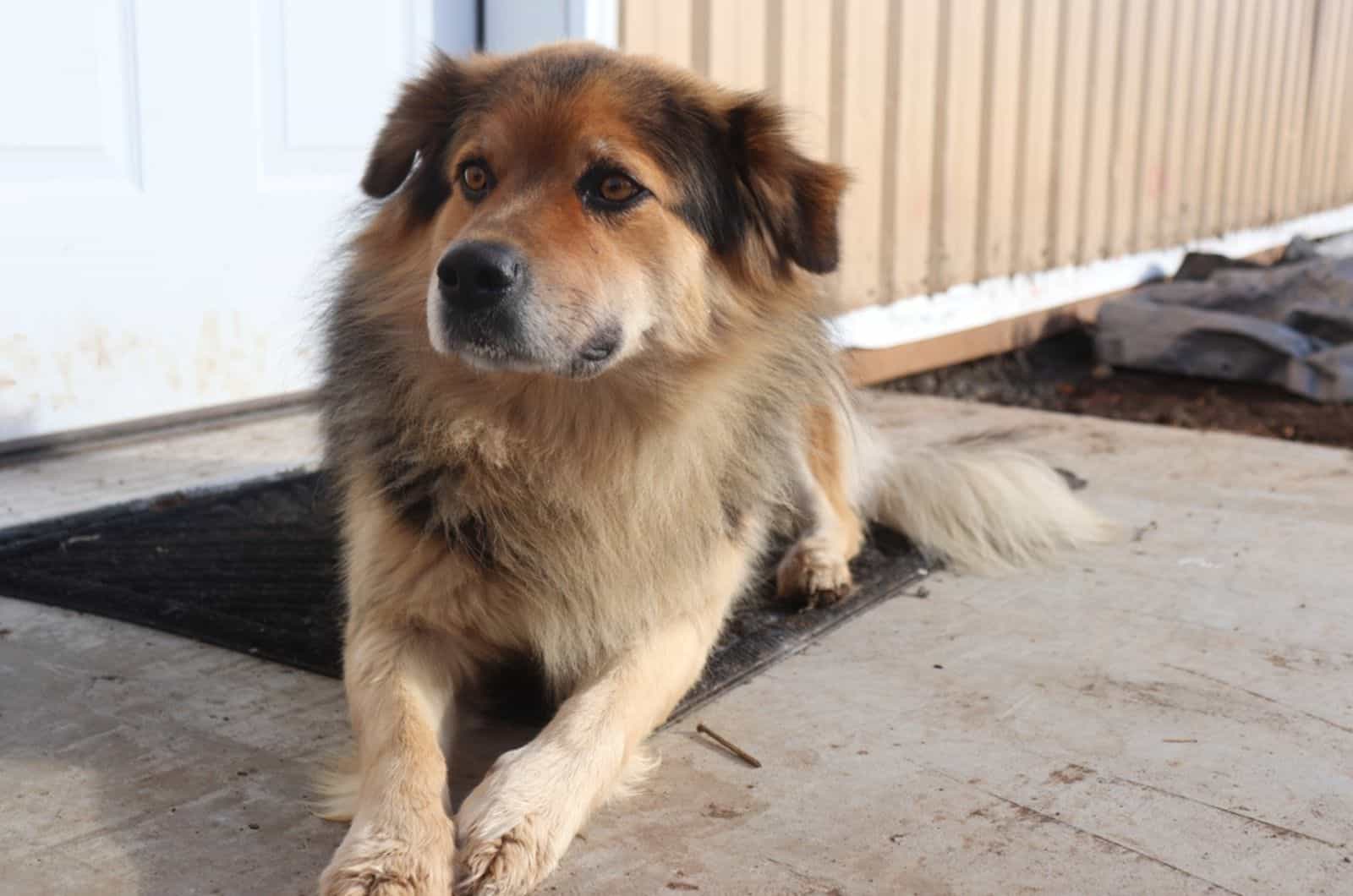
With the parents out of the way, it’s time to compile the knowledge and discover what it is about this particular hybrid dog breed that interests some dog owners.
Breed History
There isn’t much recorded history on the idea of the Coydog as a whole, but there are a few snippets, mostly hearsay from folks and mostly centered around Central America.
It’s said that the ancient Teotihuacan tribe back as early as 100 B.C. often crossbred the Coyote with some local dogs in order to get a more tame version (as Coydogs are an umbrella term) which they then used for hunting.
They believed the Coyote aspect would make them capable of handling the terrain much better than any purebred dog would.
For our particular Coydog though, the Coyote Shepherd, the first appearance would likely be much later, somewhere around the 1900s, with the highest likelihood being that of the 1990s, at least officially.
Unofficially, someone may have tried to breed a Coyote and a German Shepherd since the GSDs inception in the late 19th century, but there aren’t any records of it.
On top of that, there were likely a few incidents of the interspecific hybrid if a pack of wild Coyote were around a rural area when their mating cycles matched with that of a female GSD and they didn’t have other suitable females.
Though highly unlikely, every possibility needs to be considered.
Appearance
Given the difference in canid families, there’s no proper standard appearance for a Coyote Shepherd as the Coyote haven’t been standardized as a breed and they themselves vary between one another as seen prior.
Though there are a few key points that can be noted down at the very least.
A German Shepherd Coyote Mix Puppy tends to grow at a similar pace as a German Shepherd would.
He develops a leaner body than that of a GSD while still retaining its musculature which is now more evident, especially due to the double shaggy coat as opposed to the more sleek German Shepherd one.
Said body contains more of a rectangular shape, but still remains relatively aerodynamic, allowing the dog to reach decent speeds while running and not impeding him in any way.
The tail would be similar to that of the German Shepherd, bushy and hanging low unless on alert.
The head also appears somewhat leaner with clearly defined lines and a long muzzle with pointy ears on top.
The eyes will usually be a darker brown with the green of the Coyote rarely ever appearing, if at all.
Their size remains similar to that of the German Shepherd, coming in at around 24 to 26 inches for males and 22 to 24 inches for females, but they end up having more muscle.
Males end up weighing somewhere around 80-90 pounds while females go down to about 60-64 pounds on average with a lot of wiggle room which is why they have that leaner, more defined build.
That said, their weight isn’t set in stone either as female Coyote German Shepherd mix dogs have been known to grow bigger than their male counterparts, so do keep that in mind.
Any other features can also vary wildly which is why it’s hard to provide you with a complete guide of this specific hybrid.
Temperament
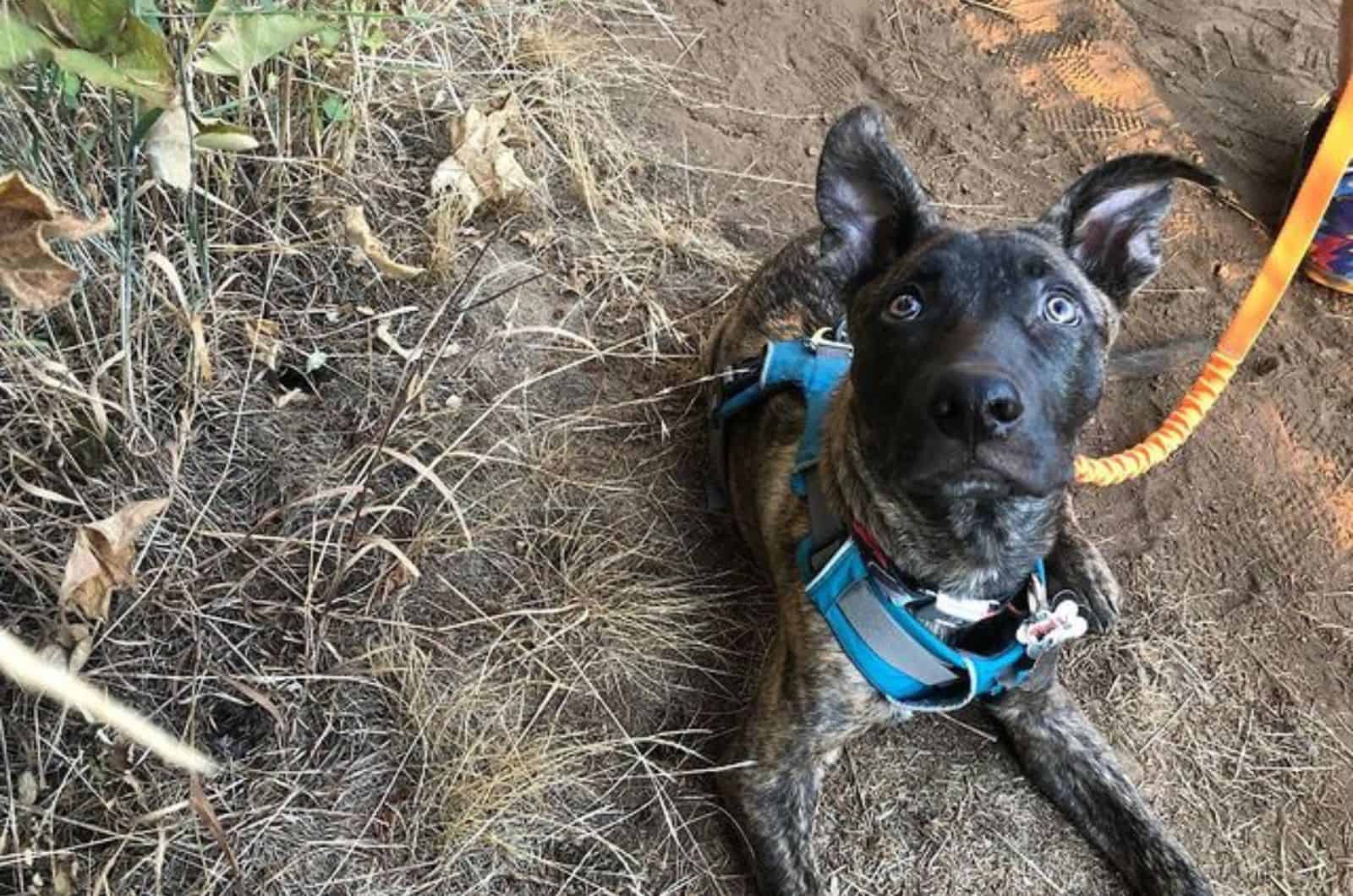
To no surprise, the temperament of the German Shepherd Coyote mix is unpredictable at best, aggressive at worst.
Sure, the German Shepherd side may be disciplined, but it’s offset by the wild and untamed nature of the Coyote parent which makes it not ideal for first time dog owners.
It can be a tossup which side you get, but I doubt it’s something you want to gamble on which is also why this particular mix doesn’t make for a good family pet.
Though various breeders of this hybrid dog breed may tell you that they’re easy to train, there are others that will contradict that and mention that only experienced dog owners should handle them.
I advise you to trust the latter as it always pays to be skeptical, no matter how much interest you may have in this particular breed as there’s no way to distinguish the bad apples from the good in a specific batch.
They’re incredibly stubborn after all, especially when paired with the hard-headedness of the German Shepherd.
That’s why it’s only recommended to attempt raising one of these if you’ve had prior experience handling tougher dog breeds.
Dog trainers can only help so much, but if you want the dog to respect your authority, you’ll have to show him discipline, otherwise even things like crate training, let alone general behavioral training, are going to be a difficult hurdle.
Coat Colors
As far as coat color goes, sable may be one of the most common ones that appears with the German Shepherd Coyote mix, but any other color is just as likely.
It mostly depends on which parent carries the dominant gene over. That said, do expect the non-standard GSD colors to have a lot lower chances of manifesting.
Grooming Needs
Even though the Coyote Shepherd has a shaggy coat, grooming should still be relatively easy.
The only time they’re really going to be an issue is when shedding season begins and their fur starts to fall off in clumps.
Be sure to give them a brushing daily when it hits, but you can keep it down to once every other day when out of season.
As for their bathing habits, bath time shouldn’t be too frequent.
Once a month ought to be enough, if not once every six weeks if your dog has sensitive skin. It can vary from dog to dog in this case.
The size of their nails is often inherited from the Coyote parent which makes them a bit cumbersome to handle.
Keeping them trimmed is important as they’re often the cause of various skin infections seeing how they’re a breeding ground for bacteria if left untrimmed for too long.
Part of grooming also involves keeping your dog fit, which involves training.
Given the Coyote’s innate higher energy levels due to living life as a wild animal, the hybrid dog’s exercise requirements will be higher than most breeds, coming in at around 2 to 3 hours of moderate physical activity daily.
This can be done through walks or through play, either works, or if you’re using him as a working dog, it can be done out on the field.
It certainly is a big time commitment which is another reason why the breed isn’t recommended for people who can’t devote a lot of time to it.
Food & Nutrition

Figuring out the right amount of food to feed to a Coyote Shepherd can be difficult as their feeding regimen doesn’t exactly fit that of most popular dog breeds so the usual feeding charts on the backs of every pack of dry dog food won’t do you any good.
Given those high energy levels mentioned prior, you’ll need to shore that up with more food than an average dog would eat.
Regular dry dog food may not end up being sufficient in some cases, so you may need to look for alternative ways to supplement the dog’s diet.
While it’s not something I recommend for any dog given the potential risks, you can try using raw meat as a potential alternative on top of the diet that you’re already putting them on.
However, I advise that you consult with your local veterinarian or pet nutritionist to assemble some sort of feeding plan or a balanced diet that you can follow and reference so you don’t go in blind every time.
Naturally, this diet will also require some fine tuning, but if there’s one thing that this mix shares with the rest of the canine world, it’s the necessities in dog food.
Here are the things you should be on the lookout for if you’re looking for a quality dog food product:
Quality Protein
Often dubbed as the first ingredient, protein is a key component of every meal and every diet, helping build up muscle mass and providing energy.
The two best protein options for any dog are beef and chicken for both quality and affordability, though alternatives such as lamb, turkey or fish do exist, though for the Coyote Shepherd in particular, stick to ones that are high in protein.
Fiber
A key addition to the mix as it helps the dog better digest the food and to absorb all the needed nutrients which is why it’s included in every good dog food out there.
The most common representatives are sweet potatoes, rice, peas and the like.
Fillers As An Alternative Calorie Source
While I normally wouldn’t recommend any owner to go for food that has fillers in its ingredient list, this is one of the rare exceptions given the sizable calorie requirements of the Coyote Shepherd as they’re just empty calories.
They don’t provide much nutritional value, but they can help meet the energy needs of the dog at the very least.
Avoid Additives
Additives, on the other hand, still remain something you should stay away from, artificial ones in particular as they’re rarely ever beneficial for your pooch and are often the cause of some particular health issues.
Omega 3 Fatty Acids
The quintessential ingredient in every bit of dog food as it helps maintain a strong and lustrous coat, reinforcing it and keeping it from falling out.
But, it also helps boost bodily functions overall, especially the immune system which is why it should never be neglected.
Probiotics
In the same vein, prebiotic fiber and probiotics are key components for allowing the growth of healthy gut bacteria which help better digest food and defend against any potential viruses and diseases, strengthening your dog’s overall immune system.
A good batch of vitamins and minerals are also welcome as they’ll help with a variety of the body’s functions.
DHA and EPA
DHA and EPA are particularly important for dogs at a very young age as they help develop and maintain their cognitive skills.
Calcium And Phosphorus
These two are particularly important for young pups as they’re the building blocks of bone and cartilage and they help maintain their quality throughout their life, slowing down any potential wear that may come to them.
Glucosamine And Chondroitin
Aside from those, you also want to include a healthy dose of chondroitin and glucosamine which help maintain bone and joint health.
They’re particularly crucial in any medium or large breed dogs given their issues with their back and joints in their senior years.
As I’ve said in every other article where I’ve mentioned these, not all of them are necessary to have in a product as that’ll be rather rare, but the more you can find in a specific one while still remaining relatively affordable, the better off your dog will be.
Health Issues & Lifespan

While the first generation hybrids will have hybrid vigor, making them less prone to health conditions and various detrimental genetic conditions, you should still be wary of the ones that could potentially affect them.
This is especially true given that, even with hybrid vigor, the health of a Coyote Shepherd isn’t all too special.
These are some of the more common health problems:
Hip And Elbow Dysplasia
Elbow and hip dysplasia are conditions that commonly affect any dog breed, and a crossbreed is no exception.
It’s what happens when the joint gets worn out and pops out of its socket, causing a great deal of discomfort for the dog in question.
It’s more likely to happen in heavier dogs due to the pressure exerted on the joint itself and isn’t curable, but proper weight management can help minimize the risks of it happening while proper treatment can help ease the pain.
Mange
Mange is a highly contagious skin disease caused by small mites that burrow under the dog’s skin and lay eggs under it.
Coyote Shepherds are prone to it given the ancestry of the Coyote being similar to that of foxes as well as a less dense amount of fur on the body providing a more favorable area for these mites to jump onto and infect.
It often leads to hair loss and severe skin irritation which can be incredibly uncomfortable for the dog so try and get it treated as quickly as you can.
While it can be handled through proper treatment, do be careful as mange can also affect humans.
Hypothyroidism
Hypothyroidism is a condition where the thyroid gland isn’t producing enough of its hormones, causing the metabolism to slow down which has an adverse effect on the dog’s body.
It’s easily noticeable if you see your dog missing patches of fur, getting a sudden increase in weight and a seeming lack of energy or full on lethargy among other symptoms, something that’s particularly strange for a Coyote Shepherd.
The condition will last him throughout his life, but he can still continue living as normal as the treatment helps keep normal hormone levels up.
Bloat
Bloat is something that affects the stomach and its surrounding organs and is what happens when your dog’s distended stomach tries to contract back into its original shape, only to twist around itself, closing off entry and exit into it.
This ends up trapping whatever liquid, gas or other stomach content there is inside and makes the surface of the stomach hard, all the while its position can cut off blood flow to surrounding organs, putting them at risk of failure.
This is a life-threatening condition and should be treated by a vet as soon as humanly possible because it is reversible, but needs to be taken care of before any permanent damage is done.
The best way to prevent it is to teach your dog to pace himself when eating and to not overeat, but even that may not fully eliminate the possibility of bloat occurring.
Parasites
Finally, parasites are another universal health problem that’s pretty common among dogs considering the things they put in their mouth without us even knowing.
This is of particular risk for Coyote Shepherds if you end up going down the raw meat supplement option.
Parasites most commonly enter the body through uncooked meat or some infested bit found on the ground that the dog swallows, latching onto their digestive tracts and nestling there, siphoning nutrients off the food he eats to feed themselves.
This leaves the dog malnourished and lethargic and can have a big impact on his growth and overall health if it happens during his puppy period as it can lead to a lot of sudden weight loss.
The best way to avoid the issue is to test your dog’s stool for worms frequently and take him to deworming procedures.
Leaving the parasite unattended can become life-threatening, so get him the help he needs as quickly as possible.
Lifespan
As far as their life expectancy goes, the average lifespan of a German Shepherd Coyote dog mix is around 10 years of age.
It’s definitely shorter than a captive coyote, but this is about par for the course for a large dog breed like the German Shepherd and a lot better than a wild Coyote by far, so I’d say they got the better end of the gene stick from their parent animals here.
Cost
As far as costs go, given the difficulty in handling this crossbreed, their price is relatively affordable, coming in at around $800 minimum with the potential of going all the way up to $1500 depending on breeder.
You may be lucky enough to find a local shelter that takes hybrid dogs in, but they may require additional training as quality isn’t assured with dogs that are left behind.
Final Thoughts
After all that, a lot of people may wonder whether the German Shepherd Coyote mix is the right breed for them, and, with all honesty, I’ll have to say that it likely isn’t unless you’re a really experienced dog owner.
This crossbreed is one of the biggest challenges to raise and an even bigger one to properly train.
There are too many factors that aren’t determined, from appearance to temperament, the latter of which affects the difficulty of handling the breed by a large margin.
This doesn’t even mention the 3 hour daily exercise requirement or the increased caloric needs to meet their high energy levels.
And the payoff really only benefits people who seek to use them as working dogs rather than family pets.
Not to mention that there isn’t a lot of data on the breed so you’re mostly going in blind aside from advice from your vet.
Normally, I’d recommend giving the hybrid a try, but in this case, it’s better if you stick to something else as it isn’t worth the effort unless you’re capable of handling this large of a task.
Until next time, pet parents.
RELATED LINKS:
- The Coyote Husky Mix Has Some Coydog Stories To Tell
- How To Identify A Full-Blooded German Shepherd
- 11 Best Sable German Shepherd Breeders In The US
- 7 Types Of German Shepherds – All Variations In One Place
- The German Shepherd Ears Chart: 7 Things You Need To Know
- German Shepherd Raw Diet Habits: Yes Or No?
- Top 7 German Shepherd Breeders In Alabama
- How Often Should You Bathe A German Shepherd? 10 Bathing Tips















